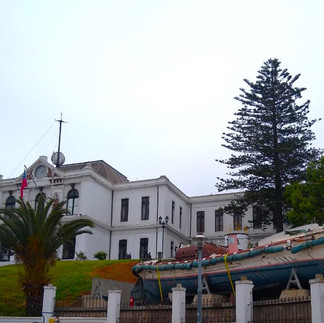How an RNLI Lifeboat Became a Little Ship of Dunkirk and Climbed a Hill in Chile
- Admin
- Dec 2, 2024
- 4 min read
The iconic view from the Museo Marítimo Nacional in Valparaíso Chile is known by many, captured in Whistler’s Nocturne in Blue and Gold and the photos of the numerous tourists who have ascended the funicular railway to reach the museum for the panorama of the harbour and port. What many will not have realised is that the view also included a Little Ship of Dunkirk – now known as the Capitán Christiansen, but originally the Walton and Frinton lifeboat, christened the E.M.E.D.
Now it is possible for everyone to see this slice of history close at hand, as the Little Ship has just been through a further adventure, moving through the streets of Valparaíso in the dead of night to reach its new berth, in prime position outside the Museo Marítimo.
But how did a Little Ship of Dunkirk end up in Chile? The E.M.E.D, a Ramsgate class lifeboat, with a 100-person capacity, was built in England in 1927 by J Samuel White. The boat was named after the initials of the four original funders. The naming ceremony was presided over by Prince George, Duke of Kent, the renegade brother of Edward VIII and youngest son of George V, who was killed in an air crash during World War II, Prince George was father to HRH Prince Michael of Kent GCVO who is the Honorary Admiral of The Association of Dunkirk Little Ships.
The E.M.E.D participated in ‘Operation Dynamo’ – in June 1940, a pivotal moment in World War II. At the request of the Admiralty a fleet – the Little Ships - of civilian ships, pleasure boats, fishing boats and 19 lifeboats helped evacuate thousands of British troops from the beach at Dunkirk. With its large capacity and moderate draft, the E.M.E.D was able to help with transporting hundreds of men from the beach out to the ships that would return them to England. The E.M.E.D was part of a group of boats, under tow of a tug to get to Dunkirk. Under intense bombardment from the German Air Force, she survived three enemy attacks off Gravelines. One boat was sunk, others turned back, the officer in charge, Lt Reginald H Mead, was killed, but the E.M.E.D went on. The ship made it back to England, despite a rope wrapped around the propeller. She went back again to Dunkirk, until the evacuation was complete, saving many lives. After the war she continued in service as the RNLI Walton and Frinton lifeboat until 1953.
She was then acquired for Chile with the help of former President Carlos Ibáñez del Campo, arriving in Valparaíso, 16 Feb 1956. The ship was renamed ´Capitán Christiansen´ in honour of the founder of the Bote Salvavidas (Lifeboats) of Valparaíso, Sr Oluf Christiansen. His brother, Andrés, had died on the beaches of Dunkirk, a member of the British expeditionary force. In 1993 the ship received the Dunkirk Jack – showing the cross of St George (the flag of the Admiralty) but including the Arms of Dunkirk, in recognition of its participation in the rescue operation.
During 34 years of continuous service in England as the Walton and Frinton Lifeboat, the boat was launched 177 times, saving 217 lives at sea. The Capitán Christiansen served nearly 40 years in Chile, saving many more lives. The ship was retired in 2001. Overall over seven decades of storms, rescue and sacrifice.
In 2002 she was loaned to the port authorities with the idea of being exhibited to the public on Muelle Baron, one of the main quays of Valparaíso. Languishing for over twenty years on the wharf, with difficulties of raising the necessary funds and wider controversies over the port development meant the Little Ship was in danger of decline beyond restitution. However, with the help of many people and the vision and determination of the Museum Director, Andrés Rodrigo Ramirez, she has been saved and now sits on a specially designed platform on the slopes of the entrance to the Museo Marítimo.
Getting her there was a further series of challenge, particularly given the size and state of the ship. The dream of getting the Little Ship to safe haven for future restoration finally became a reality in a complex logistical operation in the small hours of Saturday 19 October 2024. This was co-ordinated by the Corporación Patrimonio Marítimo
de Chile, together with the Museo Marítimo Nacional, Asmar Valparaíso, the Bote Salvavidas and the port authorities, with the help of the police and the municipal authorities. The project has been supported by the British Embassy and by the British engineering company Babcock International. The boat was carefully lifted by Crane Services Chile onto a transporter to move through the narrow streets and climb the steep winding roads of the colourful city of Valparaíso. A city, once known as the Jewel of the Pacific, with its vibrant maritime history, iconic buildings and strong British links, now facing challenges of urban decline, crime and poverty. But where valuing some of the past can also bring new opportunities for value in the future.
The Museo, traditionally a naval museum, in recent years, has opened its doors to the community, becoming a vibrant focus for events, learning and fun. The Little Ship has a part to play in drawing future visitors. The plan is not just that it will be on display for its valiant history, but also as a restoration project, which the public can both enjoy and participate, as well as providing a development space for students in conservation, history and culture and space for involvement of young people in the community, including some of the most disadvantaged. In its new home at the Museo it will be all hands on deck for the restoration of the Capitán Christiansen This Little Ship is finally in safe harbour and will help to further enhance lives, promoting culture, history and community engagement, building on the transformation of the Museo in recent years. A Little Ship on its next voyage to bring light and hope to a new future.
Fiona Clouder
(Fiona was the British Ambassador to Chile 2014-2018 and is Chairman of the Anglo Chilean Society www.anglochileansociety.org).
For more information see https://museomaritimo.cl/ and https://www.armada.cl/rescate-patrimonial-el-bote-salvavidas-capitan-christiansen-se
















Comments